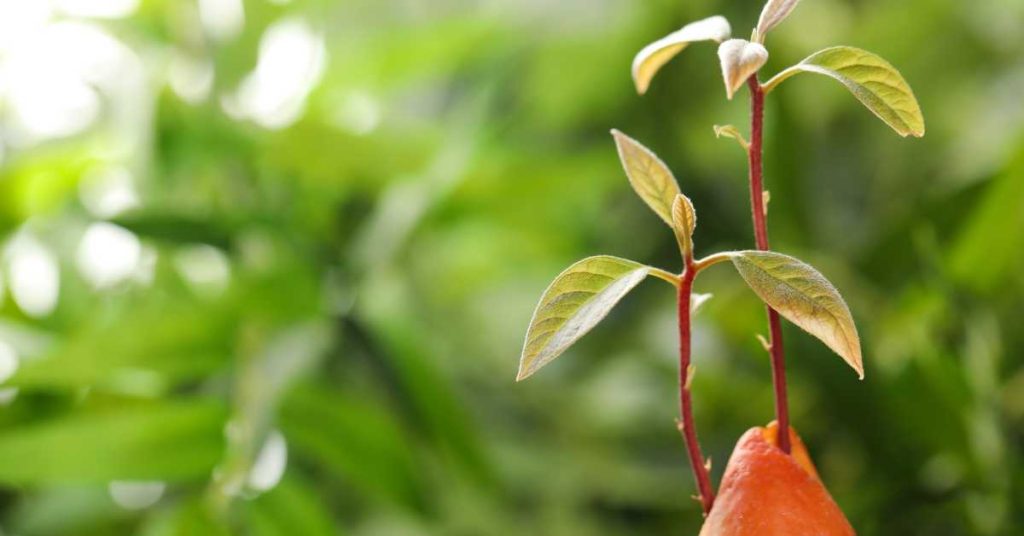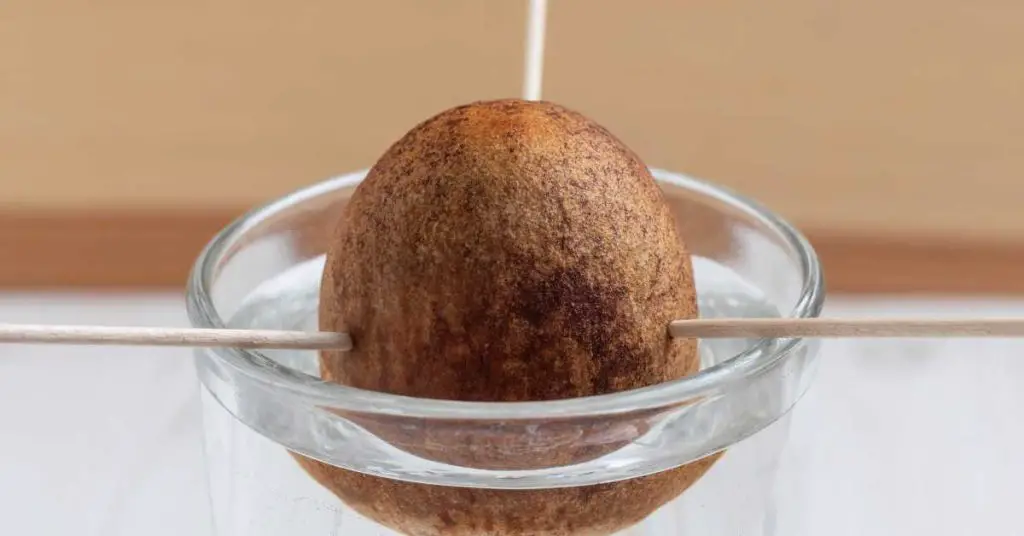Hello, green thumbs and avocado lovers! Today, we’re diving into a fun and rewarding project: growing an avocado tree from a pit. Imagine having your very own avocado tree right at home, providing fresh avocados for your meals and adding a touch of green to your space.
Growing an avocado tree from a pit isn’t just about the delicious fruit. It’s a fascinating journey that teaches you about plant growth and care. It requires patience and dedication, but the rewards are well worth it. You’ll watch a simple pit transform into a lush tree.
Whether you’re looking for a new gardening challenge or you want a fun project to share with family and friends, growing an avocado tree can be the perfect choice. Let’s get started on this green adventure together, and I’ll guide you through each step from pit to tree. Ready to grow your own avocado tree?

This post may contain affiliate links. Read our full disclosure here.
Why Grow an Avocado Tree from a Pit?
Growing an avocado tree from a pit is not only a fun and educational project but also offers several benefits that make it a rewarding endeavor. Here’s why you might consider starting this project:
Fresh Avocados
One of the most exciting reasons to grow an avocado tree is the potential to harvest your own fresh avocados. Although it takes several years for the tree to begin producing fruit, the prospect of enjoying home-grown avocados is quite appealing.
Decorative Appeal
Avocado trees have a lush, vibrant appearance that can enhance the look of your home or garden. They add a tropical flair and a bit of greenery, which can be especially welcome in urban environments.
Educational Experience
The process of growing an avocado tree from a pit can be highly educational, especially for young gardeners. It provides a hands-on lesson in botany and patience, as you observe the stages of growth from seed to tree.
Environmental Benefits
Growing your own food can reduce your carbon footprint, especially if you consume a lot of avocados. By cultivating them at home, you reduce the demand for commercially grown avocados, which often involve significant resources for transportation and production.
Cost-Effective
Avocados can be expensive to buy in stores, especially if you like to eat them regularly. Growing your own tree can eventually lead to cost savings, despite the initial investment of time and care.
Growing an avocado tree from a pit is a long-term commitment that offers numerous rewards. Not only do you get the satisfaction of watching your tree grow, but you might also eventually enjoy the fruits of your labor—quite literally.
Extracting and Preparing the Avocado Pit
To start growing your avocado tree, the first step is to extract and prepare the pit from an avocado. Here’s how to do it correctly:
- Extract the Pit: Cut around the avocado lengthwise, twisting the halves to open it. Carefully remove the pit by prying it out with a spoon or gently squeezing the halves until it pops out. Avoid using a knife to pull out the pit as this can damage it.
- Clean the Pit: Once you have the pit, rinse it under cool water to remove any remaining avocado flesh. It’s important to clean it thoroughly to prevent mold growth during germination.
- Identify the Top and Bottom: The pit has two ends – one narrow and pointy (the top) and one flat (the bottom). The roots will sprout from the bottom, and the stem will grow from the top. It’s crucial to orient the pit correctly in the next steps.
- Prepare for Germination: You need to let the pit dry for a few days in a warm, dark place. This helps the outer layer to harden slightly, making the next steps easier.
By preparing your avocado pit properly, you’re setting the stage for successful germination. The key is to handle the pit gently and ensure it’s clean and correctly oriented. Once you’ve got your pit ready, you can move on to the exciting part: germinating your future avocado tree!

Germinating the Avocado Pit
Germinating the avocado pit is an exciting stage where you start to see the first signs of life from your future tree. Here’s how to proceed with the toothpick and water method, which is the most popular and visually interesting way to sprout an avocado pit:
Toothpick Method:
- Insert Toothpicks: After your pit has dried, take four toothpicks and insert them evenly around the circumference of the pit at a slight downward angle. These will support the pit so it can be suspended over a glass of water.
- Suspend the Pit: Place the wider, flat end of the pit down into a glass filled with water. The toothpicks will rest on the rim of the glass and hold the pit so that the bottom half is submerged in water.
- Choose the Right Location: Put the glass in a warm, bright spot but out of direct sunlight. Too much sun can heat the water excessively and inhibit the growth of the roots.
Maintaining the Setup:
Change the Water Regularly: Change the water every few days to prevent bacteria and mold growth. This keeps the environment clean and promotes healthy root development.
Watch for Roots and Sprout: It can take anywhere from 2 to 6 weeks for roots and a sprout to appear. Be patient—if your pit hasn’t sprouted in a couple of months, try with a new pit.

Alternative Method – Direct Planting
If you prefer, you can plant the pit directly into soil, which some find simpler and more natural:
- Prepare a Pot: Fill a small pot with rich potting soil. Plant the pit so that the pointed end is about an inch above the soil surface.
- Moisture and Warmth: Keep the soil moist but not waterlogged and place the pot in a warm area with indirect sunlight.
- Wait for Sprouting: Like the water method, this approach requires patience. Keep the soil consistently moist as you wait for the sprout to emerge.
Germinating an avocado pit is a straightforward but slow process. Whether you choose the toothpick method or direct planting, the key is consistent care and patience. Watching the roots grow and the stem emerge is a rewarding part of the avocado-growing journey.
Planting the Sprouted Pit
Once your avocado pit has sprouted and the roots are robust, it’s time to plant it in soil. This stage is crucial for the development of a healthy avocado tree. Here’s how to do it right:
Choose the Right Pot and Soil:
- Selecting a Pot: Choose a pot that is about 8 to 10 inches in diameter with good drainage holes. This size provides enough space for the initial growth stage and helps prevent waterlogging.
- Soil Type: Use a potting mix designed for indoor plants or a mix that includes perlite, vermiculite, and peat moss, which helps ensure good drainage and aeration.
Planting the Sprouted Pit:
- Fill the Pot: Partially fill the pot with your potting mix.
- Position the Pit: Place the sprouted pit in the center of the pot. The top half of the pit should be above the soil surface. This exposure is essential as it prevents rot and allows the stem to grow freely.
- Add More Soil: Gently add more soil around the pit, securing it in place but not covering it completely. Press the soil down lightly around the base to stabilize the pit.
Aftercare:
- Watering: After planting, water the soil thoroughly until it is moist but not waterlogged. Ensure excess water can drain out to prevent root rot.
- Location: Place the pot in a location that receives indirect sunlight. Too much direct sun can stress the young plant, especially immediately after potting.
- Temperature: Keep the plant in a warm environment. Avocado trees thrive in temperatures between 60°F to 85°F (15°C to 29°C).
Planting your sprouted avocado pit is a significant milestone in growing your own avocado tree. Proper care during this stage sets the foundation for a healthy plant. Monitor the moisture levels and adjust your watering schedule as needed to accommodate the young tree’s growing needs.
With the right attention and environment, your avocado tree will continue to grow and eventually become a striking feature of your home or garden.
Caring for Your Avocado Tree
Once your avocado pit is planted and begins to grow into a young tree, it requires consistent care to thrive. Here are key aspects of caring for your avocado tree to ensure healthy development:
Watering Your Tree:
- Consistent Moisture: Avocado trees need consistent moisture to thrive but are sensitive to overwatering which can cause root rot. Water when the top inch of the soil feels dry to the touch.
- Deep Watering: Ensure water reaches deep into the roots by watering slowly and deeply. This encourages the roots to grow downward, stabilizing your growing tree.
Sunlight and Placement:
- Bright, Indirect Light: Young avocado trees benefit from bright, indirect sunlight. Direct sunlight might be too intense and can scorch the young leaves, so a spot that receives filtered light is ideal.
- Rotate Regularly: Rotate your pot every few days to ensure all sides of the plant receive equal light, promoting even growth.
Temperature and Humidity:
- Ideal Temperature: Avocado trees prefer temperatures between 60°F and 85°F (15°C to 29°C). Avoid placing your tree near cold drafts or excessively hot radiators.
- Humidity Levels: If your home is dry, especially in winter, use a humidifier or mist the leaves regularly to increase humidity around the plant.
Feeding Your Tree:
- Fertilizing: Feed your avocado tree with a balanced, water-soluble fertilizer every two to three months during the growing season. Reduce feeding in the winter when the plant’s growth naturally slows.
- Nutrient Balance: Ensure the fertilizer includes nitrogen, phosphorus, potassium, and also micronutrients like zinc and iron, which are crucial for the health of avocado trees.
Pruning and Maintenance:
- Pruning: Prune your avocado tree during the spring to encourage bushiness rather than height. Remove any dead or damaged branches to keep the tree healthy and well-shaped.
- Repotting: As your tree grows, it will need to be repotted into larger pots. Typically, young avocado trees need repotting every two to three years to accommodate root growth and ensure continued health.
Caring for your avocado tree involves monitoring and adjusting these aspects as needed. With the right care, your tree will grow strong and may eventually bear fruit, although this can take several years and often requires specific conditions. Enjoy the journey of watching your avocado tree develop, as it’s a rewarding experience that enhances your gardening skills.
Common Challenges and Solutions
Growing an avocado tree from a pit can be rewarding, but like any gardening project, it comes with its share of challenges. Here’s how to identify and address some common issues:
Slow Growth:
- Cause: Avocado trees naturally grow slowly and can be even slower indoors due to less than ideal light and temperature conditions.
- Solution: Ensure your tree is getting enough light and consider using a grow light during darker months. Keep the tree at a consistent temperature that mimics its natural tropical habitat.
Leaf Yellowing:
- Cause: Yellowing leaves can be a sign of overwatering, poor drainage, or a nutrient deficiency.
- Solution: Check the moisture level of the soil to make sure it’s not waterlogged. Improve drainage by adjusting the soil mixture or potting conditions. Use a balanced fertilizer that includes micronutrients, especially iron.
Pest Problems:
- Cause: Common pests like spider mites, aphids, and scale can affect indoor avocado trees.
- Solution: Regularly inspect your tree for signs of pests. You can treat infestations with neem oil or insecticidal soap. Keeping your tree healthy and stress-free will also make it less susceptible to pests.
Leaf Dropping:
- Cause: Leaf drop can occur due to drastic temperature changes, drought, or shock from repotting.
- Solution: Avoid placing your tree near drafty windows or heat sources that cause temperature fluctuations. Water consistently, allowing the soil to dry slightly between waterings. When repotting, try to disturb the roots as little as possible and do it during the tree’s dormant period.
Preventive Measures:
- Regularly clean the leaves with a damp cloth to remove dust and potential pests.
- Rotate your tree periodically to ensure even light exposure, which promotes balanced growth.
- Maintain a regular pruning schedule to remove dead or weak growth, which helps prevent disease and encourages more vigorous growth.
Addressing these common challenges can help you keep your avocado tree healthy and thriving indoors. By being proactive and attentive to the needs of your tree, you can enjoy the beauty and satisfaction of growing your own avocado tree from a pit.
What to Expect as Your Tree Grows
Growing an avocado tree from a pit is a long-term commitment. Here’s what you can expect as your tree matures:
Growth Rate:
- Initial Stages: In the first few years, growth may seem slow. Avocado trees grow more in spurts than at a steady rate.
- Maturing: As the tree matures, you might see more consistent growth, especially if it has optimal growing conditions—adequate light, water, and nutrients.
Transition to Outdoors:
- Feasibility: Depending on your climate, it may be possible to transition your avocado tree outdoors. Avocado trees thrive in USDA zones 9 to 11, where frosts are rare and temperatures are mild.
- Process: If you decide to move your tree outdoors, do so gradually. Start by placing it outside for a few hours each day in a sheltered location to acclimate it to the new environment, increasing the time outside over a couple of weeks.
Fruit Production:
- Time Frame: Avocado trees grown from pits can take anywhere from 5 to 13 years to begin producing fruit, and some may never produce fruit. Fruit production is more likely if you graft a branch from a fruiting tree onto your pit-grown tree.
- Factors Influencing Fruit Production: Adequate sunlight, proper watering, and correct fertilization are crucial. Pollination is also a key factor, and having another avocado tree nearby can improve fruit set.
Aesthetic Changes:
- Appearance: Over time, the tree will develop a more defined trunk and a broader canopy. Leaves may become larger and denser, giving the tree a lush, green appearance.
- Pruning for Shape: Regular pruning can help manage the tree’s size and shape, making it a more attractive indoor or outdoor plant.
Potential Challenges:
- Size Management: Indoor trees can grow larger than expected, which may require frequent pruning or eventual relocation.
- Longevity: With proper care, an avocado tree can live and produce fruit for many years, becoming a long-term resident of your garden or home.
Setting realistic expectations for the growth and development of your avocado tree will help you enjoy the journey of nurturing it from a pit to a mature tree. Remember, the process requires patience and care, but it can be incredibly rewarding, offering both aesthetic and practical benefits.
Frequently Asked Questions
How Long Does It Take for an Avocado Pit to Sprout?
It can take anywhere from 2 to 6 weeks for an avocado pit to begin sprouting, depending on factors like the freshness of the pit, the temperature, and how consistently you keep the water or soil moist. Be patient and make sure to change the water regularly if you’re using the water method, or keep the soil consistently moist if you’re using the soil method.
Can You Grow an Avocado Tree Indoors?
Yes, you can grow an avocado tree indoors, but it requires proper care and conditions. Ensure it gets enough light—about 6 to 8 hours of direct sunlight per day is ideal. If you lack sufficient natural light, supplement with grow lights. Also, maintain a temperature between 60°F and 85°F and ensure the air around the tree is not too dry.
How Often Should You Water an Avocado Tree?
Water your avocado tree when the top inch of the soil feels dry. Ensure you water deeply and allow the excess water to drain away. The frequency will depend on the environment and the size of your pot and tree; however, it generally ranges from once a week to more frequently during hot, dry periods. Overwatering can lead to root rot, so it’s important to let the soil dry out slightly between waterings.
What Are the Signs of Overwatering an Avocado Tree?
Signs of overwatering include yellowing leaves, soft and mushy spots at the base of the tree, and a general drooping or wilting of the plant. If the soil feels soggy or smells musty, it’s likely too wet. To remedy this, reduce your watering frequency, improve the drainage of your pot, and ensure the pot has enough holes to allow excess water to escape.
When Can You Expect an Avocado Tree to Start Producing Fruit?
Avocado trees grown from pits can take anywhere from 5 to 13 years to produce fruit, and some may never produce at all if grown indoors or under less-than-ideal conditions. For a higher chance of fruit production and a shorter time frame, consider grafting a branch from a fruiting avocado tree onto your pit-grown tree.
Conclusion
Congratulations on starting your journey to grow an avocado tree from a pit! This endeavor is not just a fun and educational project, but also a test of patience and dedication. Growing an avocado tree requires understanding its needs and adapting your care techniques as it matures.
As you’ve learned, from the initial stages of preparing the pit to managing a mature tree, each phase brings its own challenges and rewards. Whether your tree ultimately bears fruit or simply becomes a beautiful addition to your home, the experience of nurturing a plant from seed to tree is deeply fulfilling.
Remember to keep a close eye on environmental factors like light, water, and temperature, which are crucial for your avocado tree’s health and growth. Regular pruning, proper fertilization, and pest management will also play significant roles in the success of your tree.
Share your avocado-growing experiences with others, whether that’s through social media, gardening clubs, or with friends and family. Your journey can inspire others to start their own gardening projects, and sharing tips and insights can help you and your community grow better together.
Thank you for following along with this guide on how to grow an avocado tree from a pit. May your green thumb bring you lots of joy and perhaps even some delicious avocados in the future. Happy gardening!








